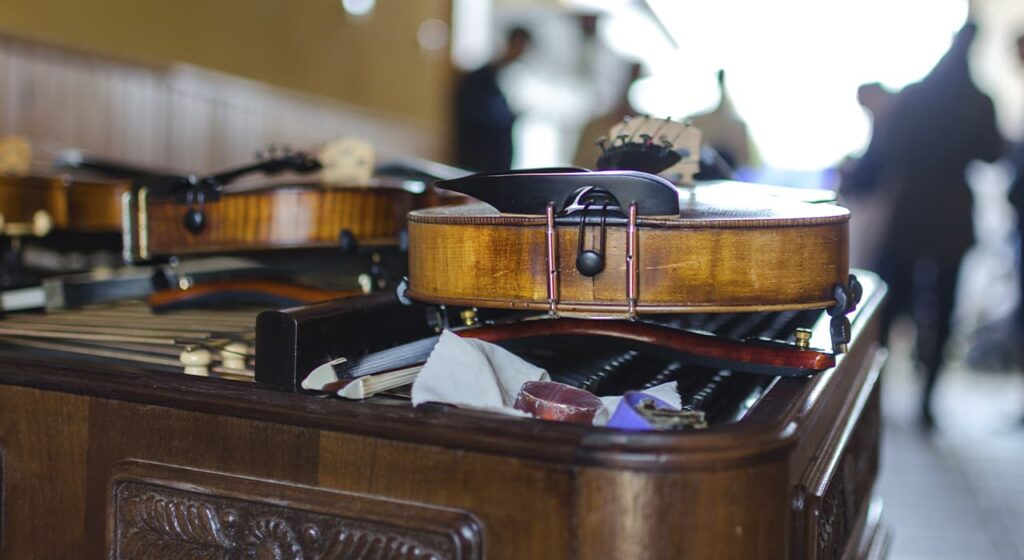20th-century music is a general term for a group of currents in art in the late 19th and early 20th centuries, in particular Modernism, acting under the motto of modernity and innovation. These movements also include Expressionism, Constructivism, Neoclassicism, as well as Dodecaphony, electronic music, etc.
MODERNISM
Music between 1910 and 1960.
The twentieth century was a time when technology changed the world. Music as an integral part of human life also underwent global change. Composers overturned many of the musical rules of the past and found new, bold themes and new ways to express them.
One of the significant figures who changed music in the first half of the century was Arnold Schoenberg, an Austrian and then American composer, conductor, and musicologist. The group of musicians he led decided that tonal music (the logical construction of proportional chords) had exhausted itself, and they proposed so-called atonal music and a 12-tone system of composition (known as “dodecaphony” or “serial technique”). Such music ceased to be melodic and harmonious; not all composers embraced their ideas.
EXPRESSIONISM
Expressionism-formed in the 1st decade of the 20th century
Expressionism in music was formed in the 1st decade of the 20th century; a number of its elements can be seen in the latest works of H. Mahler (“Song of the Earth”, 1908; the 9th, 1909 and unfinished 10th symphonies) and operas. R. Strauss (Salome, 1905; Elektra, 1908).
However, it is mostly connected with the work of composers of the so-called new Viennese school – A. Schoenberg (the head of the school), A. Berg, and A. Webern. Schoenberg, who began his path with works close to late romanticism, came to deny the romantic ideals, changing them with moods of unaccountable anxiety, fear of reality, pessimism and skepticism.
Composers of this movement developed a range of special means of musical expression; they rejected broad melodic and clear tonal foundations; the principle of atonality contributed to the expression of fragile states of mind and inexplicable vague anxiety.
Many of the works are laconic, giving only hints of some image or mental experience (in Webern’s cycle “5 Pieces for Orchestra”, 1910, some parts last less than 1 minute).
Works written in dodecaphonic technique, are based on different kinds of repetitions of so-called series, which is, according to representatives of this school, the development of the principles of formation of Baroque music and early classicism. One of the early typical examples is Schoenberg’s monodrama “Waiting” (1909).
In Webern’s work, E. is reborn in a different stylistic formation, dominated by an abstract and rationalistic constructive beginning. Therefore, it was Webern who was recognized as the founder of post-war musical avant-gardism.
Atonal music (Greek a – negative particle; literally – extra-tonal music), a concept referring to music that has no tonal organization of sounds. It emerged in the early 1900s and was associated with the composers of the new Viennese school (A. Schoenberg, A. Berg, A. Webern). The main feature of A. m. – The absence of the unifying ratio of tones with the main center of the harmony – the tonic. Hence, the amorphous musical speech, the disintegration of the harmony’s structural functions, the dissonant level of sound, etc.
CONSTRUCTIVISM
Constructivism finds expression in the combination of rigid, sharply dissonant consonances, syncopated, broken rhythmic figures. The music of Constructivism often uses jazz sounds. Despite the controversy that heated up around this trend, Constructivism as a style is alive today and enjoys well-deserved respect. Extreme direction in the art of the XX century, which received especially wide development after the First World War.
Constructivism is marked with the cult of the machine, it dehumanizes the human being, and diminishes or completely negates the ideological and emotional content of art. As applied to music, it reduces creativity to the “construction” of sound forms, the combination of various elements of the musical form.
NEOCLASSICISM
Neoclassicism – a movement in the music of the 20th century, which sought to revive the artistic images, forms and stylistic techniques of classical period music, which in this case refers to a variety of musical schools of the 18th century and earlier centuries.
Neoclassicism in music was a twentieth-century trend, especially relevant in the period between these two world wars, during which composers sought to return to the aesthetic precepts associated with the broadly defined notion of “classicism,” namely, order, balance, clarity, economy, and emotional restraint.
Also, Neoclassicism was a reaction against unrestrained emotionalism and felt the formlessness of the latter Romanticism, as well as a “call to order” after the experimental ferment of the first two decades of the twentieth century.
